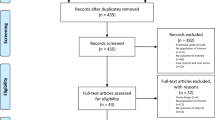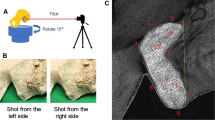Abstract
Introduction
The uncertainty about the morphological classification of the manubriosternal joint is historical in the field of Anatomy and is still under discussion. This makes it difficult to teach and diagnosing related matters, especially those that require radiological images. In fact, this subject lacks specific data.
Purpose
This study aims to describe the morphology of the manubriosternal joint and its age-related changes.
Methods
Thirty specimens were divided in three groups: young adults up to 35 years of age, middle-aged adults ranging from 36 to 55, and older adults over 56 years. The subjects were labeled, and blind analysis were performed using the macroscopic and microscopic analysis.
Results
The large presence of isolated fibroblasts and chondrocytes and the lower degree of isogenic groups proved that the manubriosternal joint is a symphysis. Its age-related changes involve the reduction of thickness and hydrated characteristics, loss of uniformity and arrangement of the collagen fibers, hyalinization and the presence of focal lesions, that corroborate with the degenerative process.
Conclusion
The manubriosternal joint is classified as symphysis and the main age-related changes is the relative thickness of the tissue.


Similar content being viewed by others
References
Gardner ED, O’Rahilly R, Müller F, Gardner ED (1986) Gardner-Gray-O’Rahilly anatomy: a regional study of human structure. Saunders, Philadelphia
Moore KL, Agur AMR, Dalley AF (2011) Essential clinical anatomy. Lippincott Williams & Wilkins, Baltimore
Kälicke T, Frangen TM, Müller EJ, Muhr G, Hopf F (2006) Traumatic manubriosternal dislocation. Arch Orthop Trauma Surg 126(6):411–416
Kothari M, Saini P, Shethna S, Dalvie S (2015) Manubriosternal dislocation with spinal fracture: a rare cause for delayed haemothorax. Chin J Traumatol 18(4):245–248
Rist A, Willscheid G, Rasch H, Paul J (2016) “Manubriosternal synchondrosis”: a rare problem in sports medicine. Sportverletz Sportschaden Organ Ges Orthopadisch-Traumatol Sportmed 30(4):229–231
Schils JP, Resnick D, Haghighi P, Trudell D, Sartoris DJ (1989) Sternocostal joints. Anatomic, radiographic and pathologic features in adult cadavers. Invest Radiol 24(8):596–603
Gray H (1989) Gray’s anatomy, 37th ed. C. Livingstone, Edinburgh
Snell RS (1986) Clinical anatomy for medical students, 3rd edn. Little, Brown, Boston
Cameron HU, Fornasier VL (1974) The manubriosternal joint–ananatomicoradiological survey. Thorax 29(4):472–474
Ehara S (2010) Manubriosternal joint: imaging features of normal anatomy and arthritis. Jpn J Radiol 28(5):329–334
Schils F (2011) O-arm guided balloon kyphoplasty: preliminary experience of 16 consecutive patients. Acta Neurochir Suppl 109:175–178
Goodman LR, Teplick SK, Kay H (1983) Computed tomography of the normal sternum. Am J Roentgenol 141(2):219–223
Petry NM (2002) A comparison of young, middle-aged, and older adult treatment-seeking pathological gamblers. Gerontologist 42(1):92–99
Tolosa EMC de, Rodrigues CJ, Behmer OA, Freitas Neto AG de (2003) Manual de técnicas para histologia normal e patológica. Editora Manole Ltda, Barueri
Ball M, Adigun OO (2018) Anatomy, angle of Louis. StatPearls Publishing. Treasure Island
Weaver AA, Schoell SL, Nguyen CM, Lynch SK, Stitzel JD (2014) Morphometric analysis of variation in the sternum with sex and age. J Morphol 275(11):1284–1299
Mescher AL, Junqueira LCU (2013) Junqueira’s basic histology: text and atlas, 13. edn. McGraw-Hill Medical, New York
Wurzinger (2009) Anatomia, 1st edn. Guanabara-Koogan, Rio de Janeiro
Ross MH, Pawlina W (2006) Histology: a text and atlas: with correlated cell and molecular biology. Lippincott Wiliams & Wilkins, Baltimore
Coventry MB, Ghormley RK, Kernohan JW (1945) The intervertebral disc: its microscopic anatomy and pathology. Part II: changes in the intervertebral disc concomitant with age. J Bone Jt Surg Am 27:233–247
Weiler C, Schietzsch M, Kirchner T, Nerlich AG, Boos N, Wuertz K (2012) Age-related changes in human cervical, thoracal and lumbar intervertebral disc exhibit a strong intra-individual correlation. Eur Spine J 21(Suppl 6):S810–S818
del Sol M, Vasconcellos A, Olave E (1999) Aspectos histologicos de la articulacion manubrioesternal. Rev Chil Anatomía 17(2):211–216
Divisi D, Di Leonardo G, Crisci R (2013) Surgical management of traumatic isolated sternal fracture and manubriosternal dislocation. J Trauma Acute Care Surg 75(5):824–829
El Ibrahimi A, Smahi M, Shimi M, Lakranbi M, Sbai H, Daoudi A, Kanjaa N, Elmrini A (2011) Traumatic manubriosternal dislocation: a new method of stabilization postreduction. J Emerg Trauma Shock 4(2):317–319
Irani AI, Lee T-Y, Estrera AL, Safi HJ (2008) Repair of a traumatic sternal deformity. J Thorac Cardiovasc Surg 136(5):1371–1372
Murala JSK, Nunn G (2009) Management of traumatic manubriosternal dislocation in children. J Thorac Cardiovasc Surg 138(2):517–518; author reply 518
Acknowledgements
The authors acknowledge the team of Doctors and Technicians of Coroner’s Office of Vitoria, especially Dr. Rogerio Piontkowsky.
Author information
Authors and Affiliations
Contributions
JM Sarcinelli: project development and data collection. R Eustáquio-Silva: project conception and manuscript writing/editing. JS Baptista: project development, data analysis and manuscript writing/editing.
Corresponding author
Ethics declarations
Conflict of interest
The authors declare no conflicts of interest.
Rights and permissions
About this article
Cite this article
Sarcinelli, J.M., Eustáquio-Silva, R. & da Silva Baptista, J. Manubriosternal joint: synchondrosis or symphysis? Analysis of morphology and aging in humans. Surg Radiol Anat 41, 275–279 (2019). https://doi.org/10.1007/s00276-018-2154-6
Received:
Accepted:
Published:
Issue Date:
DOI: https://doi.org/10.1007/s00276-018-2154-6




